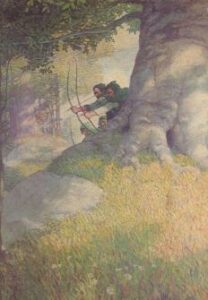N. (Newell) C. (Convers) Wyeth (October 22, 1882-October 19, 1945), is one of the most celebrated illustrators in the history of art. Best known for his book illustrations of adventure classics, his work also appeared in the Saturday Evening Post, Harper’s, Scribner’s, Collier’s, Century, Outing, and the Ladies Home Journal. He also painted historical and allegorical murals in the buildings of the Boston Public Library, the Missouri State Capital, the National Cathedral in Washington, D.C. and in numerous commercial office buildings.
Wyeth grew up on a farm in New England. He studied at the Massachusetts Normal Arts School and attended classes taught by illustrators Eric Pape and Charles W. Reed. During 1902-04 he studied with the great illustrator Howard Pyle in Wilmington, Delaware. Because Wyeth wanted to paint western scenes, he accepted a commission from Scribner’s and the Saturday Evening Post and then traveled in the west to gain first hand knowledge of his subject. On trips to the western United States, he worked as a ranch hand in Colorado and rode mail routes in New Mexico and Arizona. Notable among the series of magazine illustrations that resulted were “A Day with the Round-Up” in Scribner’s (1906) and “The Indian in His Solitude” in Outing (1907).

In 1906 Wyeth and Carolyn Brenneman Bockius were married in the Wilmington Unitarian church. They made their home in nearby Chadds Ford, Pennsylvania. The focus of his painting soon shifted to the land and people of the region in which he lived. In 1911, with a commission from Charles Scribner’s Sons to illustrate a new edition of R. L. Stevenson’s Treasure Island, Wyeth began the work upon which his fame would rest. He provided illustrations for dozens of books, including Kidnapped (1913), The Black Arrow (1916), The Legends of Robin Hood (1917), The Last of the Mohicans (1919), and The Yearling (1939).
The Wyeths were members of the First Unitarian Society of Wilmington. All their children—inventor “Nathaniel,” composer Ann Wyeth McCoy, and artists Henriette Wyeth Hurd, Carolyn and Andrew—grew up in the church, though none of them remained active Unitarian Universalists.
His wife Carolyn introduced Wyeth to Thoreau. Afterward Thoreau’s Walden served almost as the family bible. Son Andrew later complained that his mother had made his father into an intellectual by getting him to read, “and he was not that kind of man.” According to Andrew, his father approached his art with a religious spirit and called his Chadds Ford studio “my church.”
The Unitarian Laymen’s League commissioned Wyeth in 1922 to illustrate a book on the parables of Jesus. Six paintings were completed by the next year and published in the Boston Traveler. Ultimately ten of an originally proposed twenty were published in 1931 as The Parables of Jesus, with commentary by S. Parkes Cadman. Wyeth donated a painting of Jesus holding a baby to the Wilmington church in 1937.
Wyeth died at Chadds Ford in October, 1945.
The Wyeth archives and the largest collection of N. C. Wyeth’s art are at the Brandywine River Museum in Chadds Ford, PA. Collections of Wyeth illustrations are housed in the public libraries in Wilmington, Philadelphia and New York City. His letters are collected in Betsy J. Wyeth, ed., The Wyeths: The Letters of N.C. Wyeth, 1901-1945 (1971). Richard Meryman’s biography of Andrew, Andrew Wyeth: A Secret Life (1996), contains much material on N.C. Wyeth’s family life and his influence on his talented children. N.C. Wyeth: A Biography, by David Michaelis, was published in 1998.
Article by Wesley Hromatko
Publicaion date unknown